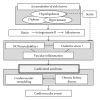Effects of statins on cardiorenal syndrome
- PMID: 22792467
- PMCID: PMC3390040
- DOI: 10.1155/2012/162545
Effects of statins on cardiorenal syndrome
Abstract
Cardiovascular disease and renal disease have a close relationship that forms a vicious cycle as a cardiorenal syndrome (CRS). Oxidative stress, endothelial dysfunction, and vascular inflammation could be therapeutic targets when the renin-angiotensin-aldosterone system is activated by accumulation of conventional cardiovascular risk factors; however, a strategy for management of CRS has not been established yet. Statins, HMG-CoA reductase inhibitors, have not only cholesterol-lowering effects but also pleiotropic effects on cardiovascular systems, including anti-inflammatory and antioxidant effects and improvement of nitric oxide bioavailability. Since recent studies have indicated that statins have beneficial effects on chronic kidney disease and heart failure as well as coronary artery disease in cholesterol-lowering-dependent/independent manners, treatment with statins might be a successful strategy for preventing deterioration of CRS.
Figures

Similar articles
-
Modulatory effects of HMG-CoA reductase inhibitors in diabetic microangiopathy.FASEB J. 2004 May;18(7):805-15. doi: 10.1096/fj.03-0839rev. FASEB J. 2004. PMID: 15117885 Review.
-
Statins: a new insight into their mechanisms of action and consequent pleiotropic effects.Pharmacol Rep. 2007 Sep-Oct;59(5):483-99. Pharmacol Rep. 2007. PMID: 18048949 Review.
-
Statins: a treatment option for chronic heart failure?Heart Fail Monit. 2004;4(3):90-7. Heart Fail Monit. 2004. PMID: 15772704 Review.
-
Statins: potential new indications in inflammatory conditions.Atheroscler Suppl. 2006 Apr;7(1):31-5. doi: 10.1016/j.atherosclerosissup.2006.01.005. Epub 2006 Feb 28. Atheroscler Suppl. 2006. PMID: 16503422 Review.
-
Pleiotropic effects of statins: evidence for benefits beyond LDL-cholesterol lowering.Am J Cardiovasc Drugs. 2010;10 Suppl 1:3-9. doi: 10.2165/1153644-S0-000000000-00000. Am J Cardiovasc Drugs. 2010. PMID: 21391728 Review.
Cited by
-
Do Statins Induce or Protect from Acute Kidney Injury and Chronic Kidney Disease: An Update Review in 2018.J Transl Int Med. 2018 Mar 28;6(1):21-25. doi: 10.2478/jtim-2018-0005. eCollection 2018 Mar. J Transl Int Med. 2018. PMID: 29607300 Free PMC article.
-
Renocardiac syndromes: physiopathology and treatment stratagems.Can J Kidney Health Dis. 2015 Oct 16;2:41. doi: 10.1186/s40697-015-0075-4. eCollection 2015. Can J Kidney Health Dis. 2015. PMID: 26478820 Free PMC article. Review.
-
Association of Decreased Docosahexaenoic Acid Level After Statin Therapy and Low Eicosapentaenoic Acid Level with In-Stent Restenosis in Patients with Acute Coronary Syndrome.J Atheroscler Thromb. 2019 Mar 1;26(3):272-281. doi: 10.5551/jat.44735. Epub 2018 Aug 21. J Atheroscler Thromb. 2019. PMID: 30135329 Free PMC article.
-
n-3 Polyunsaturated Fatty Acids: Promising Nutrients for Preventing Cardiovascular Disease.J Atheroscler Thromb. 2017 Oct 1;24(10):999-1010. doi: 10.5551/jat.RV17013. Epub 2017 Aug 24. J Atheroscler Thromb. 2017. PMID: 28835582 Free PMC article. Review.
-
A new animal model of cardiorenal syndrome could be established by inducing heart failure through coronary artery ligation in spontaneously hypertensive rats.Sci Rep. 2024 Aug 12;14(1):18732. doi: 10.1038/s41598-024-69662-3. Sci Rep. 2024. PMID: 39134654 Free PMC article.
References
-
- Bongartz LG, Cramer MJ, Doevendans PA, Joles JA, Braam B. The severe cardiorenal syndrome: ’Guyton revisited’. European Heart Journal. 2005;26(1):11–17. - PubMed
-
- Wassmann S, Laufs U, Müller K, et al. Cellular antioxidant effects of atorvastatin in vitro and in vivo. Arteriosclerosis, Thrombosis, and Vascular Biology. 2002;22(2):300–305. - PubMed
-
- Wolfrum S, Jensen KS, Liao JK. Endothelium-dependent effects of statins. Arteriosclerosis, Thrombosis, and Vascular Biology. 2003;23(5):729–736. - PubMed
-
- Laufs U, Custodis F, Böhm M. HMG-CoA reductase inhibitors in chronic heart failure: potential mechanisms of benefit and risk. Drugs. 2006;66(2):145–154. - PubMed
LinkOut - more resources
Full Text Sources

